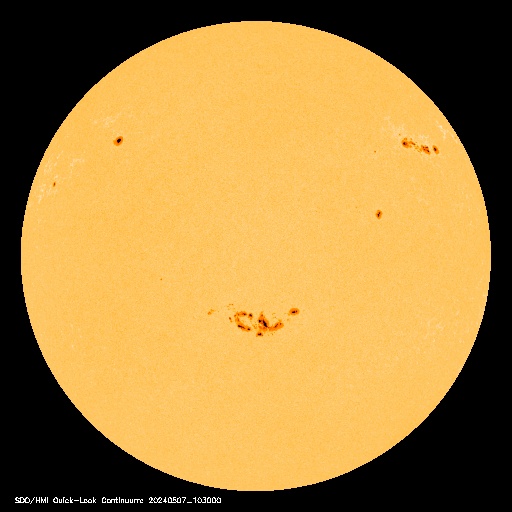Some amateurs made wonders by pointing their 2¼" refractor towards the sun. As for the Moon, small apertures can provide a detailed study of its surface.
On the Sun, we can see sunspots of course, but also faculae and granules under certain conditions.
WARNING : NEVER LOOK DIRECTLY AT THE SUN WITH AN INSTRUMENT (BINOCULARS, TELESCOPE). That causes irremediable lesions of the retina. The sensible surface of the eye can be damaged in a few seconds and this for life. It is all the more dangerous as it is painless.

Evolution of a group of sunspots (24h)
60/800R, projection with a 20 mm eyepiece.

This is why the observation of the Sun is generally done by projection, or with a full aperture solar filter, i.e. a filter which covers all the surface of the objective while placed in front of it (mylar). You can also use a Herschel helioscope (a kind of prism which lets pass only one negligible part of sunlight in the instrument). Avoid using filters "SUN" sold as accessories, THEY ARE DANGEROUS. Indeed, as the sun's light and heat concentrate close to the eyepiece : the filter heats and can burst after 30" of observation.
Here's a fun manipulation you could do: you need a room with curtains, a large projection screen, the telescope of course, and... the possibility of being able to point at the Sun starting from a window.

Once the Sun is pointed by projection, draw the curtains from the window so as to let pass only the tube of the telescope, this in order to darken the room.
It is necessary to make it as dark as possible (use clothes pins to close the curtain above and below the tube, for example).
And voilà! With your diagonal, you can direct the image of the Sun on the screen.
If your room is big, you can easily have an 1m50 wide sun image: you don't need to go to Kitt-Peak Observatory ! The darker the room, the better the contrast.


A 50 cm sun projected on a large sheet of Bristol-board.
By superimposing a sheet of paper, you can draw the sunspots.
Here is a possible result: evolution of a group of sunspots.

1987/04/11

1987/04/12
A Sun 50 cm in diameter, approximately 1m of the instrument, allows the examination of the solar granulation ("rice grains"), the faculae (white areas on the obscured edges of the Sun, which often surround the spots), and some structures in the spots' shadows.
If you are lucky enough to observe a total solar eclipse, animations like this are possible, as done by JL. Colas at the 1999 total eclipse... with a 60 mm refractor!
